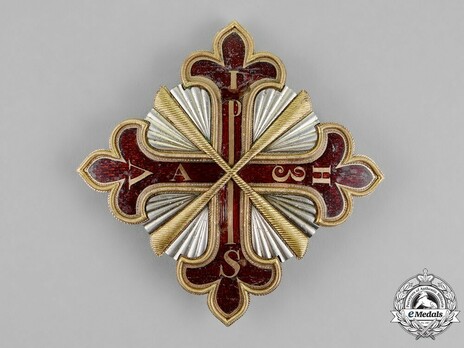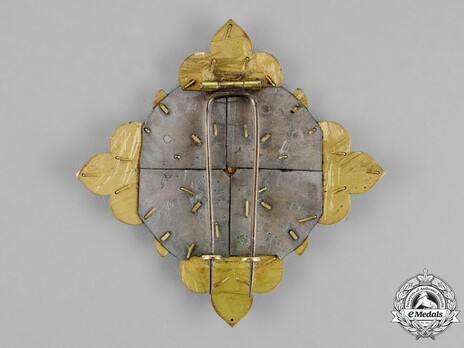Constantinian Order of St. George, Grand Cross Breast Star (embroidered, Jure Sanguinis)
CATEGORY: Version
SKU: 01.ITA.0105.103.01.003
Estimated market value:


Estimated market value:
(Ordine costantiniano di San Giorgio) This early example predates the orders transfer and absorption into the Duchy of Parma in 1731 with the death of the last male of the House of Farnese. Intractly manufactured using several layers and sections of both silver and bronze gilt, a four armed gilt cross with red enameling, a separately affixed intersecting gilt cross affixed to base by prongs, reverse with dual pin assembly, early hallmark on catch of winged bird of Paris export mark denoting manufacture and subsequent export between 1722-1727, measuring 90 mm (w) x 90 mm (h), with enamel loss and early repair to 12 o'clock arm, remains fine.
The origins of the Order are unclear. Some authorities believe the beginning of this Order can be linked to Emperor Constantine I and the Battle of the Milvan Bridge in 312. Others believe the founder was Byzantine Emperor Isaac II in 1190.
The best-recognized iteration of the Order arose with the amendments to the Order statutes made by Duke Francesco Farnese of Parma in 1705. The Duke’s changes were formally recognized by Pope Clement XI in 1706, and finalized as a dynastic Order of the Duchy of Parma by a Papul Bull in 1718.
It became a dynastic Order of the Kingdom of the Two Sicilies in 1731, following the death of Antonio Farnese, the last male descendant in Parma of the Farnese dynasty. Consequently, the Order passed to the King of the Two Sicilies, Charles III, resulting in the move of the Order out of Parma and into Naples.
Thus from 1731-1816, it was not considered an Order of the Duchy of Parma. When Marie Louise ascended to the throne of the Duchy of Parma, Piacenza and Guastalla she restored it as a dynastic Order of the Duchy of Parma, resulting in the creation of two Order branches.
The Duchy of Parma Order branch features a lower case omega in the inscription “V I H S A ω P.”
The Kingdom of the Two Sicilies Order branch features an upper case omega in the inscription “V I H S A Ω P.”
Members of the Order were predominately noble, and they were charged with defending Roman Catholic beliefs and traditions.
The motto of the Order is “In hoc signo vinces,” which roughly translates to “In this sign you will conquer.”
There is a lot of variation in the size, composition, and design of the Order awards due to the long history of the Order.
See Constantinian Order of St. George in the Orders of the Kingdom of the Two Sicilies in Italy for more information.
The Order might be awarded within the following categories: Special Class, Justice, Jure Sanguinis, Merit, Office, and Medal. Each of these has their own grades.
Special grades consist of: Sovereign Knight Grand Cross with Collar, Knight Grand Cross, and Special Class.
Justice grades consist of: Bailiff Knight Grand Cross with Collar of Justice, Bailiff Knight Grand Cross of Justice, Knight/Dame Grand Cross of Justice, Knight/Dame Grand Officer of Justice, Knight/Dame Commander of Justice, and Knight/Dame of Justice.
Jure Sanguinis grades consist of: Knight/Dame Grand Cross of Grace, or Jure Sanguinis, and Knight/Dame of Grace or Jure Sanguinis.
Merit grades consist of: Knight/Dame Grand Cross of Merit, and Knight/Dame Grand Commander of Merit, and Knight/Dame of Merit.
Office grades consist of: Knight/Dame of Office.
Medal grades consist of: Gold, silver, and bronze.
In Mb, we have tried to identified each of the previous categories, however, more research is still needed.
The design of the Grand Cross Breast Star may feature variations in composition and design. There are embroidered examples, as well as metal examples with a smooth ray design and others with a faceted ray design.
The knights of justice wore a gold breast star, those who were officers for the right of blood presented silver stars.

Comments
Sign in to comment and reply.


Scroll Top